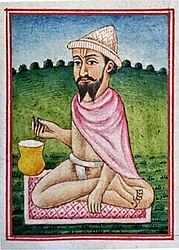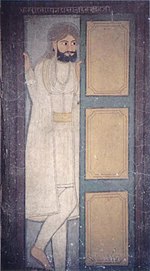 Painting of a Ramraiya ascetic of Varanasi from a folio of a manuscript of the Silsilah-i-Jogiyan, ca.1800 | |
| Founder | |
|---|---|
| Ram Rai | |
| Regions with significant populations | |
| Punjab • Uttarakhand (Dehradun) | |
| Religions | |
| Sikhism | |
| Languages | |
| Punjabi |
| Part of a series on |
| Sikhism |
|---|
 |
Ramraiyas (Gurmukhi: ਰਾਮਰਾਈਆ; rāmarā'ī'ā), also referred to as Ram Raiyas, are a Sikh sect that follow Ram Rai, the excommunicated eldest son of Guru Har Rai (1630–61).[1]
History[edit]

Ram Rai was sent by his father as an emissary to the Mughal emperor Aurangzeb in Delhi. Aurangzeb objected to a verse in the Sikh scripture (Asa ki Var) that stated, "the clay from a Musalman's grave is kneaded into potter's lump", considering it an insult to Islam. Baba Ram Rai explained that the text was miscopied and modified it, substituting "Musalman" with "Beiman" (faithless, evil) which Aurangzeb approved.[2][3][4] The willingness to change a word led Guru Har Rai to bar his son from his presence, and name his younger son as his successor. Aurangzeb responded by granting Ram Rai a jagir (fief) in the Garhwal region (Uttarakhand). The area of modern Dehradun was under the rule of King Fateh Shah of Garhwal Kingdom, whom had been commanded by Aurangzeb to facilitate Ram Rai and establish himself in the wilds of the valley, where he established his Durbar in 1676, with the work on the building finally being completed by his widow, Panjab Kaur, in 1699.[5] The town later came to be known as Dehradun, after Dehra, referring to Baba Ram Rai's shrine.[3]
Many followers of Ram Rai settled with Ram Rai, they followed Guru Nanak, but Sikhs have shunned them.[2][6] They were one of the Panj Mel, the five reprobate groups that Sikhs are expected to shun with contempt. The other four are the Minas, the Masands, the Dhirmalias, the Sir-gums (those Sikhs who accept Amrit baptism but subsequently cut their hair).[7][8]
After the death of Ram Rai, successive mahants of the Dehradun Darbar became the leaders of the sect, whom were worshiped by its followers.[citation needed]
Leaders[edit]
| No. | Name
(Birth–Death) |
Portrait | Leadership term | Reference(s) |
|---|---|---|---|---|
| 1. | Ram Rai(1645 – 1687) | 
|
? – 1687 | [1][9] |
| Mahants | ||||
| 2. | Aud Das[note 1] | 
|
1687 – 1741 | [9][10] |
| 3. | Har Prasad | 
|
1741 – 1766 | [9][10] |
| 4. | Har Sewak | 
|
1766 – 1818 | [10][11] |
| 5. | Har Swaroop Das | 
|
1818 – 1842 | [10][11] |
| 6. | Preetam Das | 
|
1842 – 1854 | [10][11] |
| 7. | Narayan Das | 
|
1854 – 1885 | [10][11] |
| 8. | Prayag Das | 
|
1885 – 1896 | [10][11] |
| 9. | Laxman Das | 
|
1896 – 1945 | [10][12] |
| 10. | Indiresh Charan Das
(14 November 1919 – 10 June 2000) |

|
1945 – 2000 | [10][13] |
| 11. | Davendra Das | 
|
2000 – present | [10][14] |
See also[edit]
Notes[edit]
- ^ According to the tradition of the Guru Ram Rai Darbar Sahib, Aud Das was the successor to Ram Rai. However, Henry George Walton in the British Garhwal: A Gazetteer, regards Har Prasad as his immediate successor, ignoring Aud Das.
References[edit]
- ^ a b "Rām Rāiyā", Encyclopædia Britannica
- ^ a b Ram Rai, Encyclopedia of Sikhism, Editor in Chief: Harbans Singh, Punjab University
- ^ a b Louis E. Fenech; W. H. McLeod (2014). Historical Dictionary of Sikhism. Rowman & Littlefield. pp. 260–261. ISBN 978-1-4422-3601-1.
- ^ Singh, Harinder (8 March 2017). "The Next Panjab Kaur". Sikh Research Institute. Retrieved 2023-05-15.
- ^ "Guru Ram Rai Gets a Historian". Garhwal Post. 13 May 2022. Retrieved 2023-05-15.
- ^ Rām Rāiyā, Encyclopædia Britannica
- ^ Arvind-Pal S. Mandair; Christopher Shackle; Gurharpal Singh (2013). Sikh Religion, Culture and Ethnicity. Taylor & Francis. pp. 36–37. ISBN 978-1-136-84634-2.
- ^ SS Kohli (1993). The Sikh and Sikhism. Atlantic Publishers. pp. 2–3.
- ^ a b c Kamboj, B. P. (2003). Early Wall Painting of Garhwal. Indus Publishing. pp. 26–29. ISBN 9788173871399.
- ^ a b c d e f g h i j "Mahants & Gurus, Darbar Shri Guru Ram Rai Ji Maharaj - Dehradun". www.sgrrdarbar.org. Retrieved 2022-08-20.
- ^ a b c d e Kamboj, B. P. (2003). Early Wall Painting of Garhwal. Indus Publishing. p. 130. ISBN 9788173871399.
- ^ Sharma, Gopi Nath (1992). Haqiqat bahida: 27-37. Haqiqat bahida: H.H. Maharana Fateh Singhji, 24th Dec. 1884 to 24 May 1930. Maharana Mewar Research Institute. p. 98.
- ^ Chandola, Anoop (2012). In the Himalayan Nights: Tales from Two Continents. Savant Books and Publications. p. 178. ISBN 9780982998700.
- ^ "Doon Sikh Welfare Society thanks Mahant Devendra Das". Garhwal Post. 5 April 2023. Retrieved 2023-05-13.